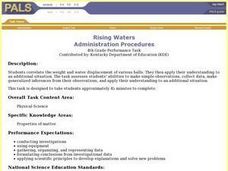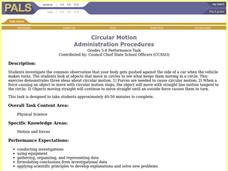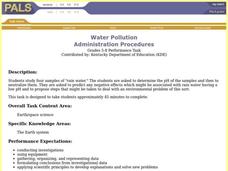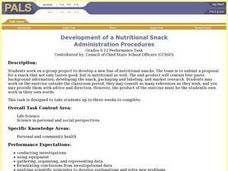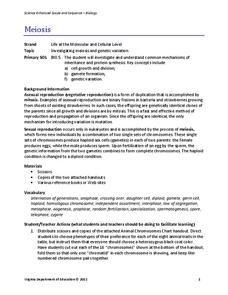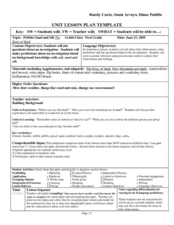Curated OER
Where the Rubber Meets the Road
Eighth graders examine two different types of tires and the effects of different factors on the amount of force needed to overcome sliding friction such as when the vehicle tries to stop.
Curated OER
Pendulum
Sixth graders are instructed on how to create a pendulum and measure the periodicity of the pendulum, using four different combinations of string. They are asked which influences the time more- the length of the string or the weight at...
Curated OER
Paper Chromatography
Pupils use this design the illustrate how ink can be separated into its component chemicals using paper chromatography. They use five unknown samples of ink on pre-labeled chromatography strips are provided to students. Pupils use...
Curated OER
Rising Waters
Fourth graders rank balls by size from smallest to largest and from lightest to heaviest and then by how much they made the water rise. They then discuss why certain balls make the water rise higher than do other balls.
Curated OER
Magnetic Mapping
Students draw arrows to show the direction the compass needle is pointing when it is placed around different points of a penny and a bar magnet. Students must then answer questions about the activity on a provided worksheet.
Curated OER
Temperature School
Pupils observ the cooling and warming of room temperature, hot, and ice cold cans of water by measuring the change in temperature over time. They then attempt to develop explanations for the observations made and apply their findings to...
Curated OER
Some of Its Parts
Pupils study a can opener to find the important parts that make it possible to take the lid off a can of food. They then use this information to decide what new or different subsystems could be added to make it better and explain how...
Curated OER
Classifying Materials
Students collect data and make observations on how given element samples respond to the field of a magnet and they calculate the density of the samples by finding the mass and volume.
Curated OER
Circular Motion
Students investigate circular motion in two different activities. In the first, students observe the path of a rolling marble on a paper plate. In the second, students play a game of catch using a tennis ball inside a plastic bag. ...
Curated OER
Water Pollution
Students study four samples of "rain water". They asked to determine the pH of the samples and then to neutralize them. Students are asked to predict any negative effects which might be associated with water having a low pH and to...
Curated OER
Identifying Elements
Students use diffraction glasses to find similarities and differences between observed spectrum of fluorescent light and an incandescent light They work in groups of 4-6 for the experiment/activity part of this exercise.
Curated OER
Sopay Water
Tenth graders design and conduct an experiment to explore the use of several substances in removing soap from water. During this activity they work with a lab partner. They keep their own individual lab notes, after they finish, they...
Curated OER
More Lizard Snacks
Students listen to Chapter I, Chapter II, Chapter III, and Chapter IV of "The Forgetful Pony". They observe different stages of development of mealworms. The student sequences pictures to show the life cycle and draws the developmental...
Curated OER
Velocity
Students determine the average speed of a toy car as it travels six different distances set up by Students. Three trials are done for each distance. The only requirements is that the longest distance must be at least three times longer...
Curated OER
Electrical Energy
Students conduct an experiment to find out how well different wires radiate heat when voltage is applied across the wire. They use the results of their experiments to consider how the gauge of the wire and the type of wire affect the...
Curated OER
Development of a Nutritional Snack
Students develop a new line of nutritional snacks. They work in teams to submit a proposal for a snack that not only tastes good, but is nutritional as well. Their end-product consists of four parts: background information, developing...
Curated OER
Meiosis
Using yarn and chenille stems, lab groups collaborate to model mitosis and meiosis. Brief background information and a vaguely written procedure comprise this outline. More instruction needs to be provided to learners about cell division...
Curated OER
The Fault Line
Students use cardboard models of the North American and Pacific plates and sand to investigate what happens when there is an earthquake or movement along the boundaries of the plates.
Curated OER
Heat Retention
Students test 4 materials to see which would be best for use as a heat mass. They then graph the temperature verus the time of the substances and decide which material would make the best heat mass.
Curated OER
Aluminum Foil Boats
Young scholars design a boat of aluminum foil and calculate the density of the boat. Washers are added to the boat until it sinks. Students then redesign boat to hold more washers and recalculate the new density.
Curated OER
Reaction Rates
Students work in groups of 4-6 for the experiment/activity part of this exercise. They base their explanation on what they observed. Students observe how substances react chemically in characteristic ways with other substances to form...
Curated OER
Scale Model of the Solar System
Students work in groups of 4-6 for the experiment/activity part of this exercise. Students know that earth is the third planet from the sun in a system that includes the moon, the sun, eight other planets and their moons, and smaller...
Curated OER
Wet-Dry Bulb Hygrometers: Measuring Relative Humidity and Apparent Temperature
Young scholars work in groups of 4 for the activity/activity part of this exercise. They know that clouds are formed by the condensation of water vapor, affect weather and climate. Also that global patterns of atmospheric movement...
Curated OER
Pebbles Sand and Silt
First graders investigate soil, sand and silt. In this environment lesson, 1st graders discuss how changes occur in the environment and the effects of weather. Students perform their own investigation and record their predictions,...





